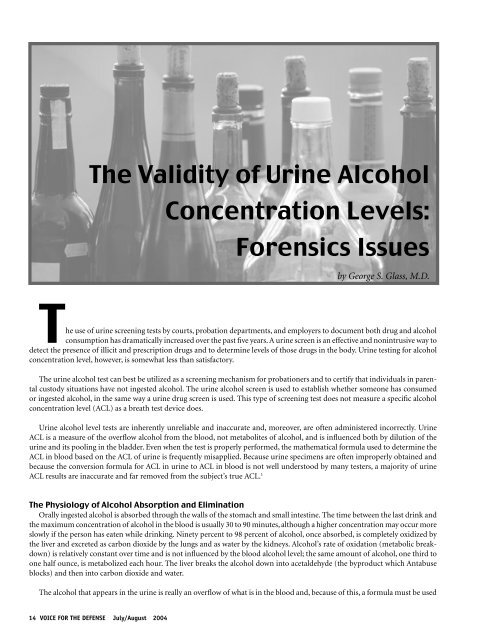July/August 2004 VOICE FOR THE DEFENSE 1
July/August 2004 VOICE FOR THE DEFENSE 1
July/August 2004 VOICE FOR THE DEFENSE 1
You also want an ePaper? Increase the reach of your titles
YUMPU automatically turns print PDFs into web optimized ePapers that Google loves.
The Validity of Urine Alcohol<br />
Concentration Levels:<br />
Forensics Issues<br />
by George S. Glass, M.D.<br />
The use of urine screening tests by courts, probation departments, and employers to document both drug and alcohol<br />
consumption has dramatically increased over the past five years. A urine screen is an effective and nonintrusive way to<br />
detect the presence of illicit and prescription drugs and to determine levels of those drugs in the body. Urine testing for alcohol<br />
concentration level, however, is somewhat less than satisfactory.<br />
The urine alcohol test can best be utilized as a screening mechanism for probationers and to certify that individuals in parental<br />
custody situations have not ingested alcohol. The urine alcohol screen is used to establish whether someone has consumed<br />
or ingested alcohol, in the same way a urine drug screen is used. This type of screening test does not measure a specific alcohol<br />
concentration level (ACL) as a breath test device does.<br />
Urine alcohol level tests are inherently unreliable and inaccurate and, moreover, are often administered incorrectly. Urine<br />
ACL is a measure of the overflow alcohol from the blood, not metabolites of alcohol, and is influenced both by dilution of the<br />
urine and its pooling in the bladder. Even when the test is properly performed, the mathematical formula used to determine the<br />
ACL in blood based on the ACL of urine is frequently misapplied. Because urine specimens are often improperly obtained and<br />
because the conversion formula for ACL in urine to ACL in blood is not well understood by many testers, a majority of urine<br />
ACL results are inaccurate and far removed from the subject’s true ACL. 1<br />
The Physiology of Alcohol Absorption and Elimination<br />
Orally ingested alcohol is absorbed through the walls of the stomach and small intestine. The time between the last drink and<br />
the maximum concentration of alcohol in the blood is usually 30 to 90 minutes, although a higher concentration may occur more<br />
slowly if the person has eaten while drinking. Ninety percent to 98 percent of alcohol, once absorbed, is completely oxidized by<br />
the liver and excreted as carbon dioxide by the lungs and as water by the kidneys. Alcohol’s rate of oxidation (metabolic breakdown)<br />
is relatively constant over time and is not influenced by the blood alcohol level; the same amount of alcohol, one third to<br />
one half ounce, is metabolized each hour. The liver breaks the alcohol down into acetaldehyde (the byproduct which Antabuse<br />
blocks) and then into carbon dioxide and water.<br />
The alcohol that appears in the urine is really an overflow of what is in the blood and, because of this, a formula must be used<br />
14 <strong>VOICE</strong> <strong>FOR</strong> <strong>THE</strong> <strong>DEFENSE</strong> <strong>July</strong>/<strong>August</strong> <strong>2004</strong>

















